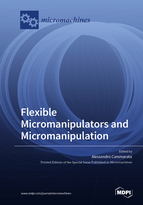Flexible Micromanipulators and Micromanipulation
A special issue of Micromachines (ISSN 2072-666X). This special issue belongs to the section "E:Engineering and Technology".
Deadline for manuscript submissions: closed (30 September 2022) | Viewed by 24473
Special Issue Editor
Interests: parallel robots; flexible multibody dynamics; compliant mechanisms; reduced order models
Special Issues, Collections and Topics in MDPI journals
Special Issue Information
Dear Colleagues,
Micromanipulation is becoming essential in many applications such as micromechanics and medicine. In microsurgery, micromanipulation is employed to repair nerves and ligaments or manipulate cells and biological samples. Microgrippers and micromanipulators are MEMS-based devices fabricated using surface micromachining. These microsystems are required to grip and move micro-objects with precision and without causing damage. The movement capability comes from compliant structures that deform under the application of actuation forces. Depending on the application, micromanipulators are required to have a wide range of motion, the right stiffness to grasp an object without damaging it, and the ability to translate and orientate an object controlling one or more degrees of freedom of its end-effector. All these features are challenging and need advanced solutions in terms of design and manufacturing. Accordingly, this Special Issue seeks to collect research papers, short communications, and review articles that focus on novel planar and spatial compliant micromanipulators.
Prof. Dr. Alessandro Cammarata
Guest Editor
Manuscript Submission Information
Manuscripts should be submitted online at www.mdpi.com by registering and logging in to this website. Once you are registered, click here to go to the submission form. Manuscripts can be submitted until the deadline. All submissions that pass pre-check are peer-reviewed. Accepted papers will be published continuously in the journal (as soon as accepted) and will be listed together on the special issue website. Research articles, review articles as well as short communications are invited. For planned papers, a title and short abstract (about 100 words) can be sent to the Editorial Office for announcement on this website.
Submitted manuscripts should not have been published previously, nor be under consideration for publication elsewhere (except conference proceedings papers). All manuscripts are thoroughly refereed through a single-blind peer-review process. A guide for authors and other relevant information for submission of manuscripts is available on the Instructions for Authors page. Micromachines is an international peer-reviewed open access monthly journal published by MDPI.
Please visit the Instructions for Authors page before submitting a manuscript. The Article Processing Charge (APC) for publication in this open access journal is 2600 CHF (Swiss Francs). Submitted papers should be well formatted and use good English. Authors may use MDPI's English editing service prior to publication or during author revisions.
Keywords
- microgripper
- microactuation
- microassembly
- comb drives
- flexure hinge
- compliant mechanism







